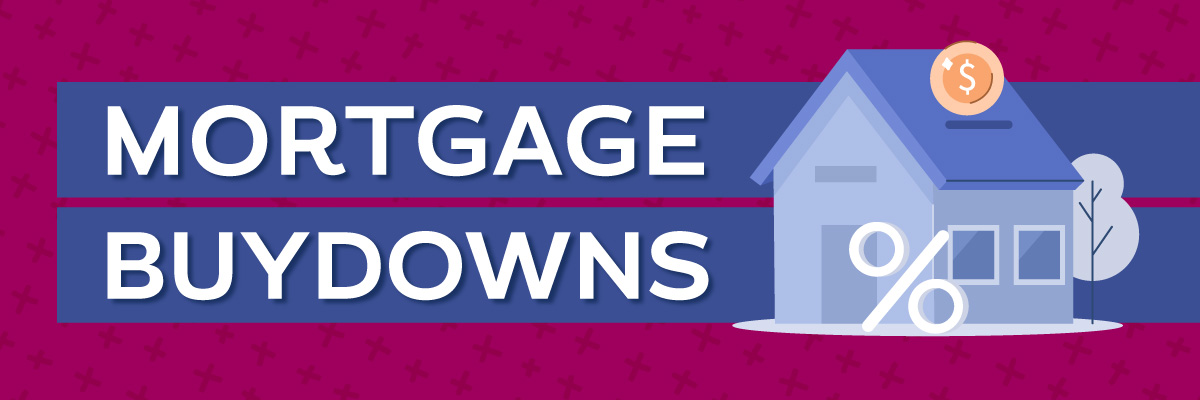Mortgage Rate Buydowns: Are They Worth the Cost?
January 6, 2023

Affordability continues to be an issue for many home buyers as mortgage rates have risen a lot in the last year, home prices continue to rise, and inventory remains low. Many are looking for alternative ways to cut down on costs while also trying to keep the dream of owning their own home alive. One of these tactics that has recently returned in popularity is a temporary buydown or mortgage buydown, a home selling strategy that was big in the late 1970s and early 1980s. Some home buyers may be wondering what is a buydown and is it the best option for me? Let’s take a deeper dive to answer these questions.
What is a Mortgage Rate Buydown?
A mortgage rate buydown is when a borrower makes a lump sum payment at closing to obtain a lower interest rate for the first few years of the loan. This payment is sometimes called mortgage or discount points which are used to make up the difference between the current rate and discounted rate. Many lenders and home sellers are offering mortgage buydowns as an incentive for would-be home buyers looking to save money in the first few years of ownership.
Different Types of Mortgage Rate Buydowns
Mortgage buydowns can be temporarily used to reduce mortgage payments at the beginning of the loan or throughout the life of the loan. The most common method used by lenders is the 2-1 buydown, which allows buyers a discounted rate for the first two years of the loan. An example of this is if I buy a home for $300,000 and the current interest rate is 6%, with a 2-1 buydown I would pay an interest rate of 4% the first year, 5% the second year, and then the full standard rate of 6% from the third year until the end of the loan term. The cost for this discounted rate varies based on your loan amount but is typically 1% of the loan. Using the example above with a reduced interest rate of 2%, approximately $6,000 would need to be paid at the time of closing. This would mean $6,672 would be saved in the first two years of ownership.
The 1-0 buydown is also a popular option used by mortgage lenders and lowers the interest rate by 1% the first year of the loan. Lastly, the 3-2-1 buydown allows buyers to lower their rate by 3% the first year of the loan, 2% the second year, and 1% in the third year.
Buyers can also obtain a permanent buydown meaning that the interest rate would stay the same over the course of the loan resulting in greater savings over time but with a heftier buydown cost at closing.
Positives and Negatives
Buying down your interest rate saves you money on your monthly mortgage payments so that you have more funds to dedicate to furnishing or repairing anything in your home. If it is offered as a concession from a seller, it may help qualify you for your home loan and could be used as a tax deductible.
If you are unable to get seller concessions for the cost, the downside is that your closing costs will increase so there may not be enough money left for a down payment. You could also potentially lose money if you decided to sell or refinance the home.
Mortgage rate buydowns can be a helpful tool for those looking to save money at a time when prices are high and mortgage rates are above 6%. Before jumping in, buyers should consider several factors, such as how long they will be staying in their home, if they want to refinance, and the upfront cost of the buydown.
For more information on housing, demographic, and economic trends in Virginia, be sure to check out Virginia REALTORS® other Economic Insights blogs.
You might also like…
Midway Through 2024, Virginia Home Sales Activity Slightly Outpacing Last Year
By Robin Spensieri - July 24, 2024
According to the June 2024 Virginia Home Sales Report released by Virginia REALTORS®, there were 10,018 homes sold across the commonwealth last month. This is 974 fewer sales… Read More
Three Multifamily Market Trends from the Second Quarter of 2024
By Sejal Naik - July 16, 2024
Each quarter, through its Multifamily Market report, the research team at Virginia REALTORS® analyzes the trends and changes in the multifamily market. Here, we share the key highlights… Read More
Takeaways From the JCHS 2024 State of the Nation’s Housing
By Dominique Fair - July 15, 2024
The Joint Center for Housing Studies from Harvard University released this year’s State of the Nation’s Housing report highlighting the impact today’s market is having on both homeowners… Read More